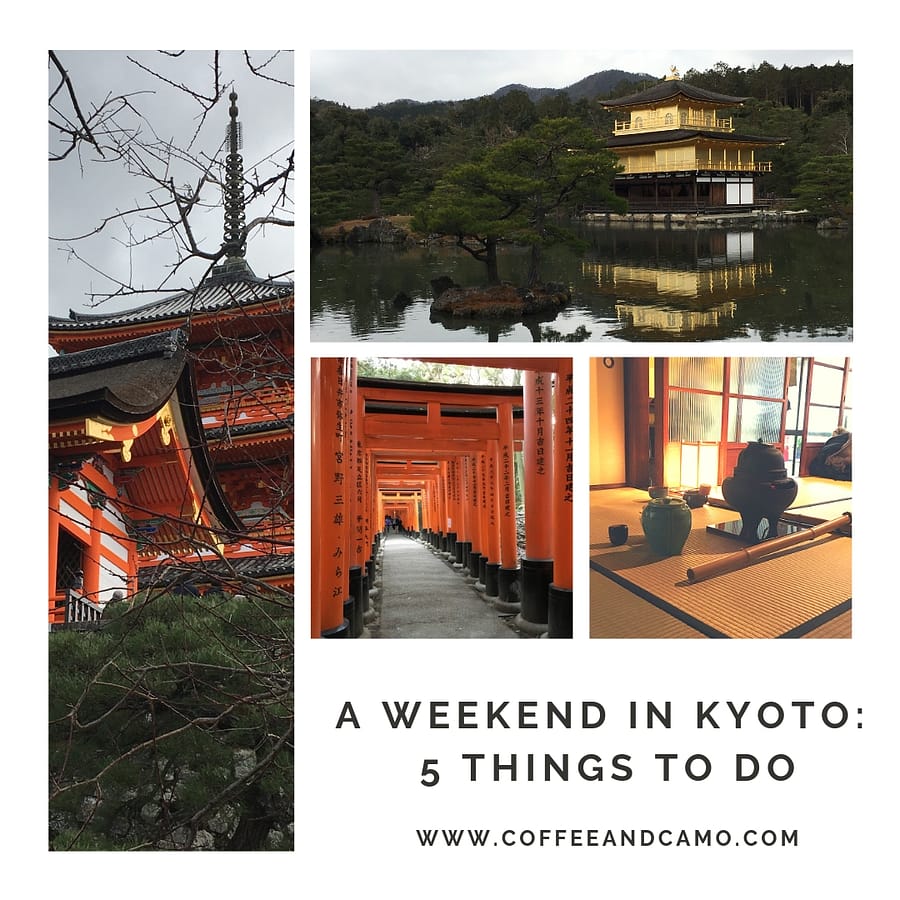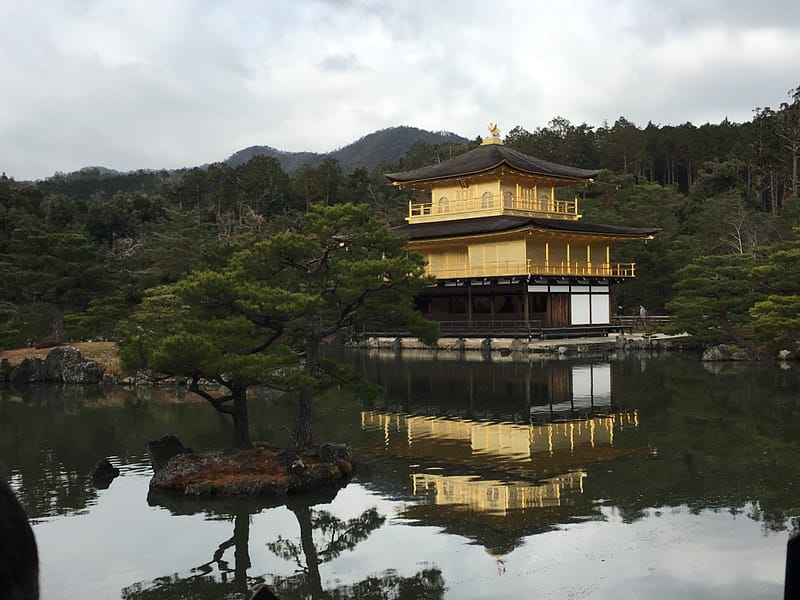Life is either a daring adventure or nothing at all. – Helen Keller
Sometimes duty calls, making it hard to get away on leave for a large block of time. Thankfully, the military calendar contains a few four-day weekends. Even if you only have a small window of time to travel, don’t sweat it! There’s a lot you can see and do in a weekend, especially in Japan. Train travel makes it incredibly easy and relatively fast to pop into a new city for the weekend. It’s no secret – Husband and I like to pack our bags and visit new places whenever we can. Because of his schedule, we take a lot of quick trips, often not spending more than 3 or 4 days in one place. This year for block leave, we spent some time visiting two new cities – Kyoto and Osaka.
For this trip, we spent about two days in each city. Our two-day “weekend” in Kyoto was actually during the week. We arrived on a Wednesday afternoon and departed Friday evening. If you can travel during the week, do it. Often, crowds and public transit are more manageable. It’s hard to see and do all the things in such a short time. To help you with your list, here are a few of our top places to see on your weekend in Kyoto.

Kinkaku-ji Temple

Recommended by one of Husband’s aunts, this temple made our list early. Kinkaku-ji is a Zen Buddhist temple located in northern Kyoto. It was originally constructed as a retirement home for Shogun Ashikaga Yoshimitsu. When he died in 1408, the complex became the temple site it is today.
Immediately, visitors notice something different about Kinkaku-ji. The most striking thing about the building is the gold leaf covering the exterior. The temple sits on the banks of a pond named Kyoko-chi, or “mirror pond”. Rightfully named, the pond’s reflective waters highlight the temple, increasing the wow factor. The morning we visited, the water was still, with only the occasional raindrop to disturb the perfect reflection.
The temple is the first thing visitors see once inside the gates, and security guards help direct traffic. Even with a large number of daily visitors, it is possible to get photos without a ton of people in them. We arrived before lunch, so I’m sure that helped a bit too. The entire visit to the temple grounds was pleasant and well organized. Signs, walking paths, and ropes make it nearly impossible to wander into off-limit areas. Although expected, it was disappointing to find our interaction with the building was quite controlled. Ropes and worn walking paths direct you around the building, but you can only get so close.
The entrance to Kinkaku-ji is well marked, and it’s easy to find by hopping a bus from Kyoto station. The admission fee to the complex is 400 yen and worth every cent.
Fushimi-inari Taisha
Fushimi-Inari Taisha shrine, also known as the Fox shrine, is number 2 on our list of things to see in Kyoto. We visited toward the end of the day, hoping to see the complex around sunset. Inari shrines are said to be one of the most well known among the Japanese population. There are 30,000 or more across the country but Fushimi-Inari Taisha, established in 711, is the head shrine.
Fushimi-Inari is one of the most well-known shrines in Kyoto because of its thousands of torii gates. It’s estimated the property has 10,000 individual gates. Companies and individuals can sponsor a torii. Inscribed on the back side of each gate are donor names and donation date.
To walk through the gates is a tight experience. At the start of the walk, there are two parallel paths – presumably one for going up and one for coming down. But it feels like a bit of a free for all, with people walking in all directions. Visiting the shrine at the sunset golden hour was a good choice. The light gave the torii tunnels a beautiful orange glow, adding to the magical feel.
We recommend budgeting some time for this visit. Because of the impending darkness, we didn’t see the full complex. The hike to the top of the hill and through all the gates is rumored to take 2-3 hours. Like other religious sites, the surrounding streets are crowded with shops and pop-up places to eat. We snacked on grilled mochi in miso sauce, a rice ball wrapped in meat, and fish cake. Many of the food stalls are 500 yen or less, so have some change on hand.
Kiyomizu-dera Temple

This temple was our first stop on our last full day in Kyoto. There’s a lot to see, and we spent more time here than we originally expected. The walk up the hill to the complex was quiet. Many of the roadside shops hadn’t opened for the day. Because it was fairly early in the morning, and a weekday, the crowds were very manageable.
The complex is large and impressive. Moving throughout the space is less structured than some of our other temple visits. There’s a good balance of “move around how you like” with “follow this route.” The first few buildings of the temple are free, including the gate structures and a large pagoda. For 400 yen, you can walk inside the temple space and through the back gardens and smaller shrines. This back area includes the famous “love stones”. Legend has it that you will find true love if you can walk between the two stones, spaced 20 meters apart, with your eyes closed. This is a popular spot, so we didn’t wait to try our luck. The garden paths offer a beautiful view of the temple. It was under construction during our visit, and construction is scheduled to continue until the spring of next year.
A special touch to our visit – it snowed. Ok, snow might be a bit of a stretch, but for a minute there were some pretty significant flurries. Overlooking the city of Kyoto in the snow – a dream!
Participate in a Tea Ceremony

As a last minute addition to our trip, we booked a tea ceremony. Neither of us had any idea what to expect, and a quick google search led us to some options for places to go. We settled on Tea Ceremony En, a small tea house in the Gion district. The ceremony was done in English, and we were accompanied by about 10 other foreigners.
At first, the staff gave a short explanation of the harvesting and production of matcha. Then, they described and explained some of the elements used in the ceremony. The ceremony itself is very much like a performance, and each movement and gesture has a specific meaning. The ceremony was short and completed without explanation. After she finished, the staff explained some of the movements and their meaning. Finally, we got to make our own tea. Neither Husband nor I were very good at the whisking of the matcha and water, causing a lack of bubbles in our tea. We both need a little more practice.
The cost was a little high, priced at 2500 yen a person for an hour ceremony. Husband and I both agreed it was worth it one time. We both wanted to learn a bit about matcha since it is such an important part of Japanese culture. We were asked not to take pictures during the event, and I forgot to take some as we made our tea. It was a unique and somewhat intimate experience shared with other travelers.
Nishiki Market

Nishiki Market was one of our last stops in Kyoto. At the time, Husband and I were mission-oriented, on the hunt for somewhere to have a pint and some food before hopping the train to Osaka. I wish we had spent more time here and this is definitely on our list of places to re-visit. Like many Japanese markets, the area is a food-lovers paradise. There were many things on sticks to try, and the area smelled like fresh fish. The market was covered, giving us and the hundreds of other visitors a break from the wintry mix outside. Aside from food, visitors can also find unique clothing and gifts. This definitely makes the list of things to do when we go back to Kyoto.
Getting Around in Kyoto

Kyoto is a city full of tourists. Many people come to visit the old capital of Japan. With over 1,000 shrines and temples, it’s easy to see why. To help visitors get around, the city offers a city subway/bus pass. You can purchase either a one day ticket for 900 yen, or a two-day ticket for 1,700 yen. It’s important to note the two-day pass must be used on consecutive days. The ticket is good on subway lines within Kyoto and city buses.
Husband and I each bought a ticket, but we found the ticket barely paid for itself. Because we don’t have kids, we find walking between places often leads us on unexpected adventures. Plus, we’re not so great at using the city bus system. Most buses within Kyoto had a flat fare of 230 yen. If you’re using the buses to get around, it’s likely your pass will pay for itself. Kyoto only has a few subway lines, and they often didn’t go where we wanted them to. Although we used the subways a few times, we found with a little motivation, we could walk to most places.
It’s worth it to look into a transit pass, and the city offers other options as well. Passes are available at commuter pass booths or Kyoto subway stations.
To get to Kyoto, we traveled by train from Tokyo. We arrived well before our hotel check-in time, so we made good use of the coin lockers at the train station. If you’ve never used a coin locker, rest easy: these things are great! It’s so nice to wander without luggage. At most train stations, coin lockers are abundant, cheap, and safe. I recommend dropping a pin in Google maps to remember exactly where you dropped your stuff.
Hopefully, this list has given you a jumpstart in planning your weekend in Kyoto. Husband and I were able to see all this and more in our two-day visit. Make sure to leave a comment and share your Kyoto itinerary! We’re always looking for new places to explore. Happy travels!




